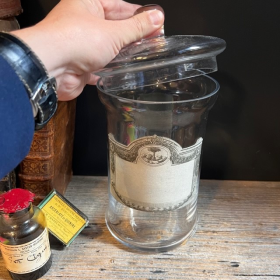
Antique Guyon bladder syringe in bakelite - Beginning of...
Antique Guyon bladder syringe in bakelite
Beginning of XXth century









Herbalist's or Pharmacist's jar
Antique blank label of the XVIIIth century
Antique Herbalist's or Pharmacist's jar
The jar and its lid are made of mouth-blown glass, there is still the trace of the cane's pontil under the jar.
These jars in the shape of a candy jar with a lid were rarer and are difficult to find today. They were often put forward to show the opulence of the pharmacist's shop.
An antique blank label of the XVIIIth century was affixed on the jar.
The coat of arms of the apothecaries appears there:
The coat of arms represents the palm tree, representing plant medicines, the snake, representing medicines from animals, and the rocks, representing minerals. This coat of arms reminds us that the apothecary is educated in these three kingdoms, mineral, vegetable and animal.
Blazon dating from after 1777 and before the transformation of apothecaries into pharmacists in 1791.
Height 26cm with cover Diameter: 12.6cm Weight: 1Kg
Sold empty
Antique Guyon bladder syringe in bakelite
Beginning of XXth century
Gencivol for babies' teeth
Antique pharmacy bottle
Apothecary
An antique absinthe topette (decanter)
5 Beaded Topette
Laxiline tablets
Antique tin medicine box
Empty
Manuel complet de Physique et de Météorologie - Complete Manual of Physics and Meteorology
By Ajasson de Grandsagne and L. Fouché
Second edition published in Brussels in 1835
Illustrated with 6 folding plates depicting more than 250 figures. (torn: see photos)
JOLY oil-free black ink for rubber stamps
Antique bottle
There is ink left inside
Iron filings
Antique pharmacy bottle - Apothecary
Teinture de Cantharides - POISON
Lytta vesicatoria - Spanish fly
Antique blue glass pharmacy bottle - Apothecary
Early 20th century - Blown glass.
Dry sodium iodide
Antique pharmacy bottle - drugstore - apothecary
Museum jar - Wet specimen
Soft coral Alcyonium palmatum
Portable autopsy kit from the mid-19th century
Maison Charrière in Paris, circa 1845–1870
Mahogany case for autopsy and dissection
Small portable mahogany case containing a set of autopsy instruments: hook hammer, bone chisel, enterotome scissors, probes, hooks and suture needles. Used by forensic scientists and anatomists for opening and examining bodies.
Charrière, a major 19th-century Parisian manufacturer, was a pioneer in the design of high-precision surgical and anatomical instruments.
Mahogany and polished steel: 23 × 11 cm
Please note: crack in the wood under the case
A beautiful object, very rare to find
Bulb for hypodermic injection - Camphor (circa 1920)
THERAPLIX
Antique metal bladder syringe of Dr Guyon
Beginning of XXth century
non-functional
Doctor Louis Jubé pure blood transfusion syringe
For arm-to-arm transfusions
In its metal box
Around 1925/1930
Grams / Teaspoons in French: Grammes / Cuillères à café
Antique medicine bottle
Apothecary
A Treatise on Surgery
By Dr Reclus and Dr Duplay
Antique illustrated book from 1891
Volume 4

Herbalist's or Pharmacist's jar
Antique blank label of the XVIIIth century









